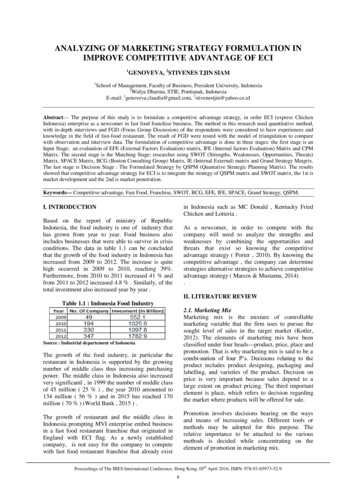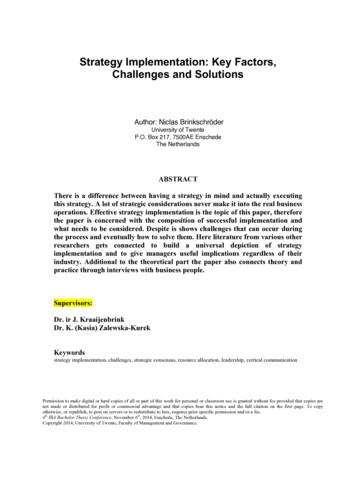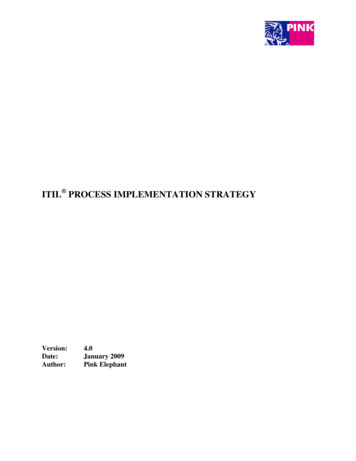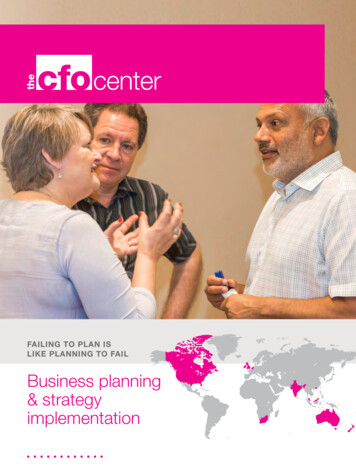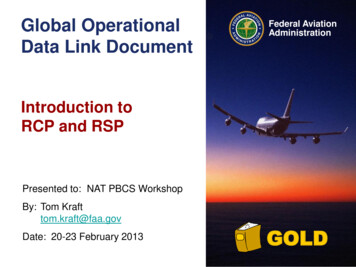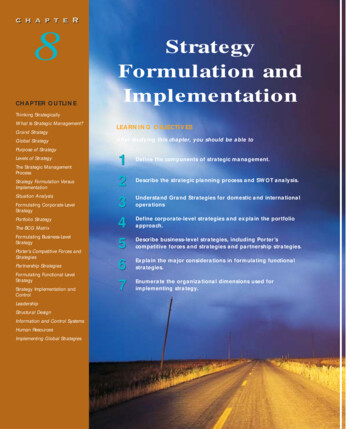
Transcription
chapteR8CHAPTER OUTLINEStrategyFormulation andImplementationThinking StrategicallyWhat Is Strategic Management?Grand StrategyGlobal StrategyLEARNING OBJECTIVESAfter studying this chapter, you should be able toPurpose of StrategyLevels of StrategyThe Strategic ManagementProcessStrategy Formulation VersusImplementationSituation AnalysisFormulating Corporate-LevelStrategyPortfolio StrategyThe BCG MatrixFormulating Business-LevelStrategyPorter’s Competitive Forces andStrategiesPartnership StrategiesFormulating Functional-LevelStrategyStrategy Implementation andControlLeadershipStructural DesignInformation and Control SystemsHuman ResourcesImplementing Global Strategies1234567Define the components of strategic management.Describe the strategic planning process and SWOT analysis.Understand Grand Strategies for domestic and internationaloperationsDefine corporate-level strategies and explain the portfolioapproach.Describe business-level strategies, including Porter’scompetitive forces and strategies and partnership strategies.Explain the major considerations in formulating functionalstrategies.Enumerate the organizational dimensions used forimplementing strategy.
Management ChallengeCoke might be the world’s most powerfulrespected companies. During his first year onbrand, but that has not helped much lately.the job, Daft began dismantling the stale oldWhen Douglas Daft took over as CEO of theregime at headquarters and brought in newCoca-Cola Company, he inherited a host oftop managers willing to make the toughtroubles. Soda sales had slumped in thechanges to turn the company around. He alsoimportant U.S. market and to a lesser extentspent much of his time repairing relationshipsaround the world, and Coke had failed towith government regulators in Europe andmatch rival Pepsi’s aggressive moves intohandling the backlash from financiallynonsoda businesses. A high-profile racialstrapped bottlers who charged that Coke haddiscrimination suit in the United States andbeen trying to eke out profits at the bottlers’a soda-contamination scare overseas hadexpense. Despite these early moves, Coke’sdamaged the company’s reputation and itssales and profits have stayed flat and the stockrelationships with customers, governments,has continued to decline. The CEO knows heand bottlers. Under the previous CEO, M.needs to come up with a powerful strategicDouglas Ivester, there was no real sense ofplan to reignite the company in a hurry.1crisis at Coke’s headquarters, where managers pretty much continued business asIf you were the CEO of Coca-Cola, what strate-usual. The Australian-born Daft knew thatgies might you adopt to regain the competitiveneeded to change if Coca-Cola was to remainedge? How would you go about formulating andone of the world’s most admired andimplementing a new strategic plan?1
2CHAPTER 8Strategy Formulation and ImplementationThe story of Coca-Cola illustrates the importance of strategic planning. Cokehad been stumbling along for years, ever since the departure of belovedChairman and CEO Roberto Goizueta. The late Goizueta had been a master atproviding vision and strategic direction for the company, but his hand-pickedsuccessor, Douglas Ivester, proved incapable of keeping Coke on the path ofsuccess. Now, employees, board members, and investors are hoping DouglasDaft can formulate and implement strategies that can ignite growth and revivethe troubled company.Every company is concerned with strategy. Japan’s Fuji Photo FilmCompany developed a strategy of being a low-cost provider to compete withKodak. Fuji’s relentless internal cost-cutting enabled the company to offercustomers lower prices and gradually gain market share over the giant U.S.firm.2 Hershey devised a new strategy of being a fierce product innovator tocompete with Mars in the candy wars.3 Hershey scored big with the introduction of such products as Twizzlers twisted licorice sticks, Jolly Rancher lollipops, and Bites, bite-sized pieces of favorite candy bars. Strategic blunderscan hurt a company. Mattel suffered in recent years by losing sight of its corebusiness and trying to compete as a maker of computer games. New CEORobert A. Eckert has implemented a “back to basics” strategy that he hopeswill get the toymaker back on track.4Managers at Mattel, Hershey, Fuji, and Coca-Cola are all involved in strategic management. They are finding ways to respond to competitors, cope withdifficult environmental changes, meet changing customer needs, and effectively use available resources. Research has shown that strategic thinking andplanning positively affects a firm’s performance and financial success.5 Strategicplanning has taken on new importance in today’s world of globalization, deregulation, advancing technology, and changing demographics and lifestyles.Managers are responsible for positioning their organizations for success in aworld that is constantly changing. Today’s top companies thrive by changingthe rules of an industry to their advantage or by creating entirely new industries.6 For example, Champion Enterprises was going broke selling inexpensive, factory-built houses. CEO Walter Young Jr. says, “People thought we werein the trailer park business. It was a real perception problem.” Young wanted toredraw the rules of the manufactured housing industry. Today, Champion isthriving by building full-size houses in its factories and offering customerssuch options as porches, skylights, and whirlpool baths.7In this chapter, we focus on the topic of strategic management. First wedefine components of strategic management and then discuss a model of thestrategic management process. Next we examine several models of strategyformulation. Finally, we discuss the tools managers use to implement theirstrategic plans.Thinking StrategicallyChapter 7 provided an overview of the types of goals and plans that organizations use. In this chapter, we will explore strategic management, which isconsidered one specific type of planning. Strategic planning in for-profitbusiness organizations typically pertains to competitive actions in the marketplace. In not-for-profit organizations such as the Red Cross, strategicplanning pertains to events in the external environment. The final responsibility for strategy rests with top managers and the chief executive. For anorganization to succeed, the CEO must be actively involved in making the
Thinking Strategicallytough choices and trade-offs that define and support strategy.8 However,senior executives at such companies as General Electric, 3M, and Johnson& Johnson want middle- and low-level managers to think strategically. Somecompanies also are finding ways to get front-line workers involved in strategic thinking and planning. Strategic thinking means to take the long-termview and to see the big picture, including the organization and the competitive environment, and to consider how they fit together. Understanding thestrategy concept, the levels of strategy, and strategy formulation versusimplementation is an important start toward strategic thinking.What Is Strategic Management?Strategic management is the set of decisions and actions used to formulateand implement strategies that will provide a competitively superior fitbetween the organization and its environment so as to achieve organizationalgoals.9 Managers ask questions such as, “What changes and trends are occurring in the competitive environment? Who are our customers? What productsor services should we offer? How can we offer those products and servicesmost efficiently?” Answers to these questions help managers make choicesabout how to position their organization in the environment with respect torival companies.10 Superior organizational performance is not a matter ofluck. It is determined by the choices that managers make. Top executives usestrategic management to define an overall direction for the organization,which is the firm’s grand strategy.3strategic managementThe set of decisions and actions used toformulate and implement strategies that willprovide a competitively superior fitbetween the organization and its environment so as to achieve organizationalgoals.grand strategyThe general plan of major action by whichan organization intends to achieve its longterm goals.Grand StrategyGrowth. Growth can be promoted internally by investing in expansion orexternally by acquiring additional business divisions. Internal growth caninclude development of new or changed products, such as Starbucks’ introduction of Frappuccino, a bottled coffee drink, or expansion of current productsinto new markets, such as Avon’s attempt to begin selling products in major retailstores. External growth typically involves diversification, which means the acquisition of businesses that are related to current product lines or that take the corporation into new areas. The number of companies choosing to grow throughmergers and acquisitions is astounding, as organizations strive to acquire the sizeand resources to compete on a global scale, to invest in new technology, and tocontrol distribution channels and guarantee access to markets. WorldCom, oncean obscure long-distance carrier, has acquired more than 40 companies in thepast decade and expanded into local phone services, data transmission, andInternet traffic. Another strategy for international growth is the formation of ajoint venture, such as WorldCom’s venture with Spanish telecom giantTelefónica, which extended WorldCom’s reach into South America.12 This chapter’s Leading Online box describes how eBay is pursuing a growth strategy.Stability. Stability, sometimes called a pause strategy, means that the organization wants to remain the same size or grow slowly and in a controlled fashion. Chuck EatonGrand strategy is the general plan of major action by which a firm intends toachieve its long-term goals.11 Grand strategies fall into three general categories: growth, stability, and retrenchment. A separate grand strategy can alsobe defined for global operations.Kingsley Management LLC is pursuing agrowth strategy with its high-tech carwashes trademarked “Swash.” So far, theBoston-based company has single-bay carwashes in only three markets—Rochester,New York, Greenville, North Carolina,and Jacksonville, Florida—but foundersMatthew Lieb (standing) and Chris Jones(in the driver’s seat) are aiming for growthby forming partnerships to add their stateof-the-art car washes to gas stations andhypermarkets and developing plans formulti-bay units in high-traffic areas. AtSwash, a customer pulls up to an ATM-likemachine, pays with cash, credit, or a prepaid card, watches video instructions, andgets a software-controlled brushless wash,all in less than five minutes.
4CHAPTER 8Strategy Formulation and ImplementationLeading OnlineEBay: Building on SuccessAt a time when almost every Internet and technology company is handing out pink slips, the scene is quite different within the walls of San Jose, California-based eBay. Infact, the online auction company is planning to add to its workforce of 2,400. EBay, which began as a site for selling collectibles, is pursuing a growth strategy, successfully moldingitself into a platform for selling everything from computers toclothes. Every 60 minutes on the site, 120 PCs, 10 diamondrings, and 1,200 articles of clothing are sold, and someonebuys a Corvette every three hours.EBay CEO Meg Whitman sees her biggest job as keepingthe company nimble and maintaining community spirit as theorganization grows. From day one, eBay has been profitable,and in the second quarter of 2001, the company reportedprofits of 24.6 million, more than triple those reported ayear earlier. Part of the reason for the success is because topmanagers have kept their focus on the community of buyersand sellers even as they have invested steadily in the company’s growth.There are several elements to eBay’s strategic plan forgrowth. First, to branch out from its auction format, the company purchased Half.com, a site where new and used itemscan be listed at a fixed price. In addition, the company addeda new feature called “Buy It Now,” which allows users toacquire an item immediately, omitting the time-consumingauction process altogether. About 35 percent of all items listedby sellers on eBay now offer that option, which speeds up therate of trading on the site. Another approach has been toallow businesses such as J. C. Penney, IBM, and SunMicrosystems to set up virtual storefronts. Ebay expected toattract around 2,000 businesses, but nearly 10 times thatnumber wanted a piece of the action, recognizing the inexpensive potential for reaching millions of consumers. On theglobal front, eBay has acquired iBazar, a European tradingsite, and invested in the growth of its German, Canadian, andU.K. operations.Mark Goldstein, former CEO of BlueLight.com, the onlineunit of Kmart, says, “eBay is what all of us wanted our Internetbusinesses to be.” Even as e-commerce stalls in today’sdeclining economy, online shoppers-turned-bargain-hunterssurf the value-priced aisles of eBay, finding anything andeverything. In fact, eBay is rapidly becoming “the Wal-Martof the Internet.”SOURCE: Miguel Helft, “What Makes eBay Unstoppable?” The Industry Standard(August 6–13, 2001), 32–37.The corporation wants to stay in its current business, such as Allied TireStores, whose motto is, “We just sell tires.” After organizations have undergone a turbulent period of rapid growth, executives often focus on a stabilitystrategy to integrate strategic business units and ensure that the organizationis working efficiently. Mattel is currently pursuing a stability strategy torecover from former CEO Jill Barad’s years of big acquisitions and new businesses. The current top executive is seeking only modest new ventures to getMattel on a slower-growth, more stable course.13Retrenchment. Retrenchment means that the organization goes through aperiod of forced decline by either shrinking current bus
Formulating Business-Level Strategy Porter’s Competitive Forces and Strategies Partnership Strategies Formulating Functional-Level Strategy Strategy Implementation and Control Leadership Structural Design Information and Control Systems Human Resources Implementing Global Strategies 8 Strategy Formulation and Implementation LEARNING OBJECTIVES After studying this chapter, you should be
